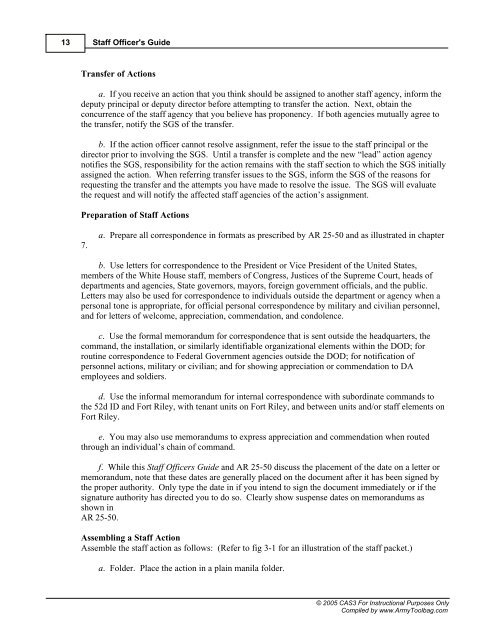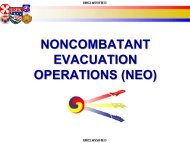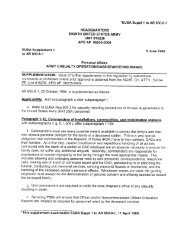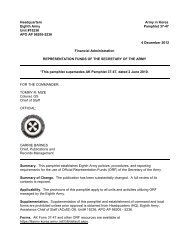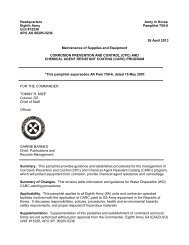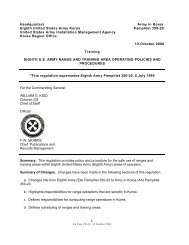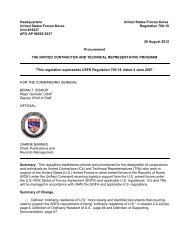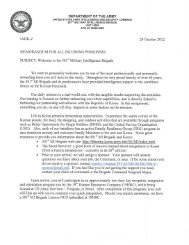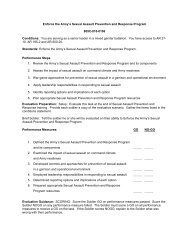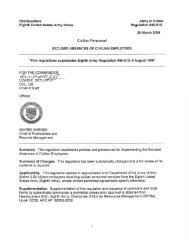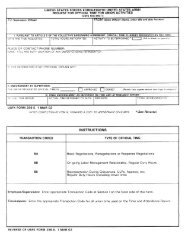CAS3 Staff Officer Guide - U.S. Army
CAS3 Staff Officer Guide - U.S. Army
CAS3 Staff Officer Guide - U.S. Army
You also want an ePaper? Increase the reach of your titles
YUMPU automatically turns print PDFs into web optimized ePapers that Google loves.
13<br />
<strong>Staff</strong> <strong>Officer</strong>'s <strong>Guide</strong><br />
Transfer of Actions<br />
a. If you receive an action that you think should be assigned to another staff agency, inform the<br />
deputy principal or deputy director before attempting to transfer the action. Next, obtain the<br />
concurrence of the staff agency that you believe has proponency. If both agencies mutually agree to<br />
the transfer, notify the SGS of the transfer.<br />
b. If the action officer cannot resolve assignment, refer the issue to the staff principal or the<br />
director prior to involving the SGS. Until a transfer is complete and the new “lead” action agency<br />
notifies the SGS, responsibility for the action remains with the staff section to which the SGS initially<br />
assigned the action. When referring transfer issues to the SGS, inform the SGS of the reasons for<br />
requesting the transfer and the attempts you have made to resolve the issue. The SGS will evaluate<br />
the request and will notify the affected staff agencies of the action’s assignment.<br />
Preparation of <strong>Staff</strong> Actions<br />
7.<br />
a. Prepare all correspondence in formats as prescribed by AR 25-50 and as illustrated in chapter<br />
b. Use letters for correspondence to the President or Vice President of the United States,<br />
members of the White House staff, members of Congress, Justices of the Supreme Court, heads of<br />
departments and agencies, State governors, mayors, foreign government officials, and the public.<br />
Letters may also be used for correspondence to individuals outside the department or agency when a<br />
personal tone is appropriate, for official personal correspondence by military and civilian personnel,<br />
and for letters of welcome, appreciation, commendation, and condolence.<br />
c. Use the formal memorandum for correspondence that is sent outside the headquarters, the<br />
command, the installation, or similarly identifiable organizational elements within the DOD; for<br />
routine correspondence to Federal Government agencies outside the DOD; for notification of<br />
personnel actions, military or civilian; and for showing appreciation or commendation to DA<br />
employees and soldiers.<br />
d. Use the informal memorandum for internal correspondence with subordinate commands to<br />
the 52d ID and Fort Riley, with tenant units on Fort Riley, and between units and/or staff elements on<br />
Fort Riley.<br />
e. You may also use memorandums to express appreciation and commendation when routed<br />
through an individual’s chain of command.<br />
f. While this <strong>Staff</strong> <strong>Officer</strong>s <strong>Guide</strong> and AR 25-50 discuss the placement of the date on a letter or<br />
memorandum, note that these dates are generally placed on the document after it has been signed by<br />
the proper authority. Only type the date in if you intend to sign the document immediately or if the<br />
signature authority has directed you to do so. Clearly show suspense dates on memorandums as<br />
shown in<br />
AR 25-50.<br />
Assembling a <strong>Staff</strong> Action<br />
Assemble the staff action as follows: (Refer to fig 3-1 for an illustration of the staff packet.)<br />
a. Folder. Place the action in a plain manila folder.<br />
© 2005 <strong>CAS3</strong> For Instructional Purposes Only<br />
Compiled by www.<strong>Army</strong>Toolbag.com


